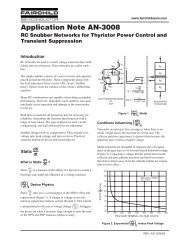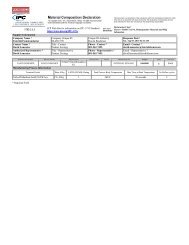Half-Bridge LLC Resonant Converter Design Using FSFR-Series ...
Half-Bridge LLC Resonant Converter Design Using FSFR-Series ...
Half-Bridge LLC Resonant Converter Design Using FSFR-Series ...
Create successful ePaper yourself
Turn your PDF publications into a flip-book with our unique Google optimized e-Paper software.
AN-4151 APPLICATION NOTE<br />
2. Consideration for Integrated<br />
Transformer<br />
For practical design, it is common to implement the<br />
magnetic components (series inductor and shunt inductor)<br />
using an integrated transformer; where the leakage<br />
inductance is used as a series inductor, while the<br />
magnetizing inductor is used as a shunt inductor. When<br />
building the magnetizing components in this way, the<br />
equivalent circuit in Figure 6 should be modified as shown<br />
in Figure 8 because the leakage inductance exists, not only<br />
in the primary side, but also in the secondary side. Not<br />
considering the leakage inductance in the transformer<br />
secondary side generally results in an incorrect design.<br />
V in<br />
+<br />
V F<br />
in<br />
V d<br />
+<br />
-<br />
Cr<br />
C r<br />
L L L n L<br />
Llkp Lm//<br />
Llkp<br />
L L L<br />
L r<br />
L lkp<br />
L p -L r<br />
L m<br />
2<br />
r lkp m //( lks )<br />
p lkp m<br />
-<br />
n:1<br />
1: V M<br />
L lks<br />
+<br />
V RI<br />
-<br />
Lp<br />
( MV<br />
)<br />
L L<br />
ideal<br />
transformer<br />
Rac<br />
p r<br />
+<br />
VO R o<br />
-<br />
+<br />
V F<br />
RO<br />
F (nV ) RI<br />
-<br />
Figure 8. Modified Equivalent Circuit to Accommodate<br />
the Secondary-side Leakage Inductance<br />
In Figure 8, the effective series inductor (Lp) and shunt<br />
inductor (Lp-Lr) are obtained by assuming n 2 Llks=Llkp and<br />
referring the secondary-side leakage inductance to the<br />
primary side as:<br />
L L L<br />
p m lkp<br />
r lkp m //(<br />
2<br />
lks) lkp m // lkp<br />
L L L n L L L L<br />
When handling an actual transformer, equivalent circuit<br />
with Lp and Lr is preferred since these values can be easily<br />
measured with a given transformer. In an actual<br />
transformer, Lp and Lr can be measured in the primary side<br />
with the secondary-side winding open circuited and short<br />
circuited, respectively.<br />
In Figure 9, notice that a virtual gain MV is introduced,<br />
which is caused by the secondary-side leakage inductance.<br />
By adjusting the gain equation of Equation 6 using the<br />
modified equivalent circuit of Figure 9, the gain equation<br />
for integrated transformer is obtained:<br />
(8)<br />
<br />
m MV<br />
2nV<br />
M <br />
V<br />
( 1) j( ) ( 1) ( m1) Q<br />
O<br />
2<br />
( )<br />
o<br />
( 1)<br />
in<br />
2<br />
<br />
2<br />
<br />
2<br />
p o 2<br />
o<br />
<br />
( ) mm ( 1)<br />
<br />
<br />
(<br />
<br />
<br />
1) j( ) ( <br />
1) ( m1) Q<br />
2<br />
2<br />
o<br />
2 2<br />
2 2<br />
p o o<br />
2<br />
e 8n<br />
Ro Lp<br />
Rac , m<br />
2 2<br />
where: MV Lr<br />
e<br />
Q <br />
Lr<br />
C<br />
1<br />
, e o <br />
R<br />
1<br />
LC<br />
, p<br />
<br />
1<br />
LC<br />
r ac r r p r<br />
The gain at the resonant frequency (ωo) is fixed regardless<br />
of the load variation, which is given as:<br />
Lp m<br />
M MV ato<br />
L L m1<br />
© 2007 Fairchild Semiconductor Corporation www.fairchildsemi.com<br />
Rev. 1.0.1 • 5/15/12 4<br />
p r<br />
e<br />
e<br />
(9)<br />
(10)<br />
The gain at the resonant frequency (ωo) is unity when<br />
using individual core for series inductor, as shown in<br />
Equation 7. However, when implementing the magnetic<br />
components with integrated transformer, the gain at the<br />
resonant frequency (ωo) is larger than unity due to the<br />
virtual gain caused by the leakage inductance in the<br />
transformer secondary side.<br />
The gain of Equation 9 is plotted in Figure 10 for different<br />
Q e values with m=3, fo=100kHz, and fp=57kHz. As observed<br />
in Figure 9, the <strong>LLC</strong> resonant converter shows gain<br />
characteristics almost independent of the load when the<br />
switching frequency is around the resonant frequency, fo.<br />
Gain ( 2nV o / V in )<br />
Qe 2.2<br />
=0.25<br />
2.0<br />
1.8<br />
1.6<br />
1.4<br />
1.2<br />
1.0<br />
1<br />
f p <br />
2<br />
L C<br />
p r<br />
Q e =1.0<br />
M M<br />
1<br />
fo<br />
<br />
2<br />
LrCr @ fo V<br />
e<br />
Q <br />
Lr / Cr<br />
e<br />
Rac<br />
Q e =1.00<br />
Q e =0.75<br />
Q e =0.50<br />
Q e =0.25<br />
0.8<br />
40 50 60 70 80 90<br />
freq (kHz)<br />
100 110 120 130 140<br />
Figure 9. Typical Gain Curves of <strong>LLC</strong> <strong>Resonant</strong><br />
<strong>Converter</strong> (m=3) <strong>Using</strong> an Integrated Transformer







